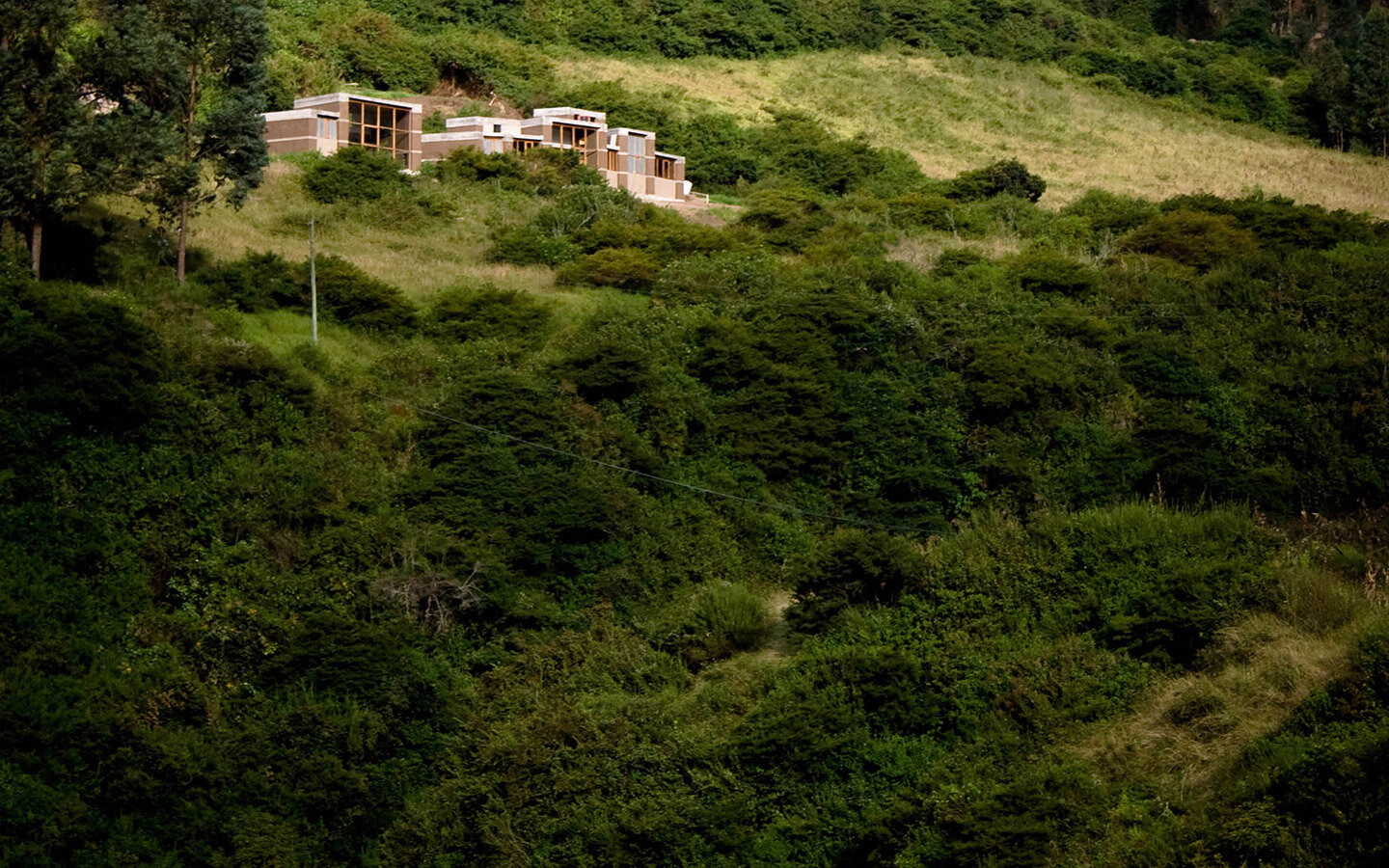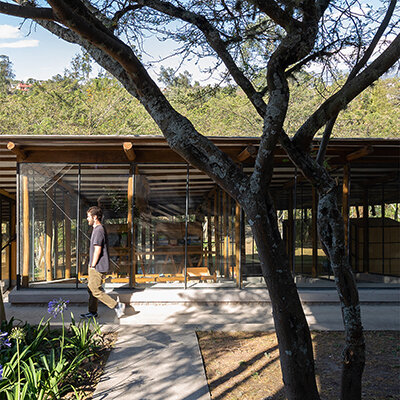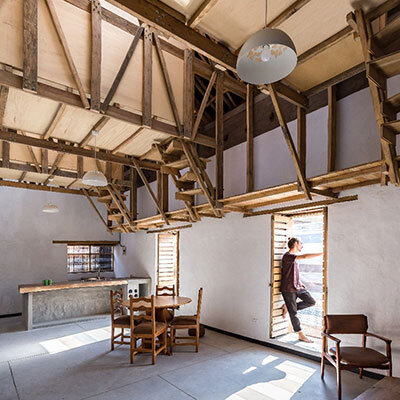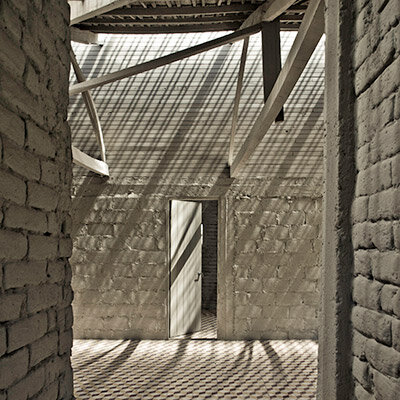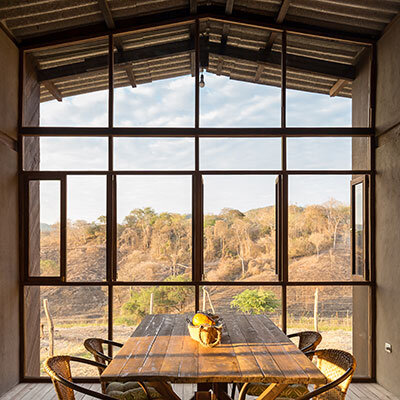casa entre muros
Entre Muros House
2014, Nominado - Mies Crown Hall Americas Prize / IIT-Illinois Institut of Technology / Chicago, EEUU
2014, Nominee - Mies Crown Hall Americas Prize / IIT-Illinois Institut of Technology / Chicago, USA
-
Arquitectos: Al Borde
Cliente: Carla Flor
Especialista en Tapial: Arq. Bolívar Romero
Construcción: Miguel Ramos
Ubicación: Tumbaco, Quito, Ecuador
Año: 2008
Fotografía: Raed Gindeya, Antonio Flores & Al Borde
-
El deseo de establecerse por siempre en un espacio que lo sienta como suyo, la búsqueda por vivir en armonía con la naturaleza, la necesidad de autonomía de los tres miembros que conforman la familia, el bajo presupuesto entendido como optimización de espacios y recursos, y la frase “Siempre hay otra manera de hacer las cosas y otra manera de vivir”, acuñada por Ella, se convirtieron en el punto de partida para nuestro trabajo.
Alejada de Quito y del vértigo de la ciudad, la casa se implanta en las faldas del volcán Ilaló en un terreno indómito de alta pendiente, limitado por dos quebradas, abierto a la vista del valle. Un corte en el terreno inclinado permite generar una plataforma para el asentamiento del proyecto y suficiente materia prima para generar gruesos muros de carga. La forma ondulada e irregular resultante del corte en el terreno, define la disposición ordenada y rectilínea de cada muro de tapial. La sucesión de estos tapiales y las distintas alturas de la cubierta provoca que la vivienda se fisione en espacios ya sea por usuario o actividad puesto que la casa se la entiende como la secuencia de refugios individuales. Para evitar el efecto dominó los muros rompen su paralelismo resolviendo la estructura y fortaleciendo el carácter de cada “refugio”. Para tomar conciencia de la gran sección de los tapiales excavamos los muros y en ellos disponemos el mobiliario como estrategia de optimización del espacio. La circulación, concentrada en un extenso corredor, conforma un elemento que aísla el proyecto de los vecinos inmediatos, refuerza la autonomía de cada espacio y promueve la apertura de estos hacia la atractiva vista.
PIDIENDO PERMISO AL ILALÓ
La relación armónica entre naturaleza y objeto construido es muy importante para su dueña y determinante en el diseño, proceso constructivo y funcionamiento de la casa:
1. Siguiendo tradiciones ancestrales se hace una ceremonia de pedido de permiso al volcán, ofrendas y buenos augurios son enterrados generando un centro energético en el espacio que divide lo social de lo privado. La casa se entrega con una ceremonia de limpieza de malas energías finalmente se deposita una ofrenda en el centro energético que funciona como punto de contacto entre los usuarios y el volcán.
2. Las aguas grises van a piscinas de tratamiento convirtiéndolas en aguas de riego, se diseña un baño seco y un sistema de calentamiento de agua solar. La madera y caña han sido cortadas en buena luna para evitar el uso de productos químicos en su tratamiento.
3. La tierra como material de construcción genera bajo impacto en su entorno, la materia prima sale del desbanque en el terreno, no produce escombros, almacena calor y regula el clima interior al tener capacidad de absorber y desorber la humedad más rápido y en mayor cantidad que otros materiales.
Esta arquitectura busca poner en evidencia la naturaleza material de los elementos que la componen, potenciando sus cualidades estéticas, formales, estructurales y funcionales.
-
Architects: Al Borde
Client: Carla Flor
Rammed Earth Advisor: Arq. Bolívar Romero
Construction: Miguel Ramos
Location: Tumbaco, Quito, Ecuador
Year: 2008
Photography: Raed Gindeya, Antonio Flores & Al Borde
-
The wish to set up, the search for living in harmony with nature, the need of autonomy for each one of the three members of the family, the low budget (understood as the optimization of resources and spaces) and the phrase: "There is always another way of doing things and another way for living", settled by her, were the starting point for the design.
Far from the pollution of the city, the house is set in the hillside of the Ilaló volcano in a indomitable land. It's limited by two streams opened to the landscape of the valley. A cut in the sloping land helps to generate a platform for the project and also to get enough raw material to build the gravity walls. The waving form as a result of this cut in the land, defines the position and order of every wall. The succession of these adobe walls and the different heights of the roof caused the division of the house even for the activity or the user.
In order to get rid off the domino effect, the gravity walls break their parallelism solving the structure and strengthening the character (spirit) of every "refuge". The furniture is worked inside the thick adobe walls. The long corridor is used as an element that isolates the project from their immediate neighboors and reinforces the autonomy of every space.
This architecture aims to highlight the nature of the material elements that compose it, promoting the aesthetic, formal, functional and structural qualities as well as the maximum respect of the environment.
ASKING PERMISSION TO THE ILALÓ VOLCANO
The harmonious relation between the nature and the architecture is very important for the owner and also a decisive fact for the design, constructive process and the operation of the house.
1. Following ancient customs, a ceremony is prepared to ask permission to the volcano. There, presents and the best auguries are buried creating an energetic centre in the space that divides the social area from the private one. The house is cleaned of bad energies in the ceremony, and finally an offering is put into the energetic centre which works as a meeting point between the users and the volcano.
2. The gray waters go to processing pools turning them into irrigating waters. A dry bath and a solar system to heat the water are designed. The wood and reed-grass have been cut in “good moon” to avoid the usage of chemical products for its treatment against plagues.
3. The land like material of construction generates low impact in the projects environment. The raw material comes out of the generated cut in the sloping land. It does not produce rubbles, stores heat and regulates the interior climate by having the aptitude to absorb and desorber the dampness more rapid and in major quantity than other materials.
ENLACES
LINKS
2024, CAPBA Fascículos - N4 / CAPBA
2022, 厄瓜多尔墙间住宅 / Archdaily China
2022 / Entre Muros House / Archdaily
2022 / Casa Entre Muros / Archdaily Brasil
2022 / Casa Entre Muros / Archdaily Español
2022 / Entre Muros House / Arquidust
2020 / Casa Entre Muros / Red Fundamentos
2020 / Casa de muros de tierra de AL BORDE / Tectonicablog














